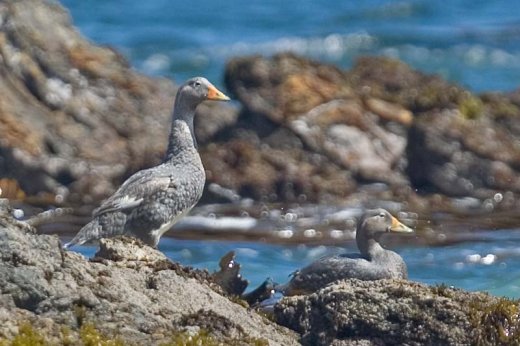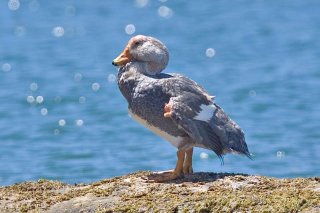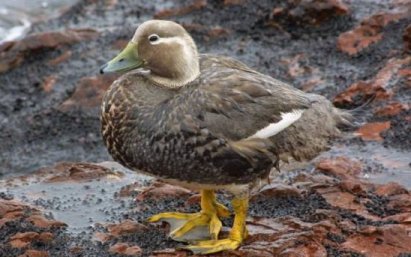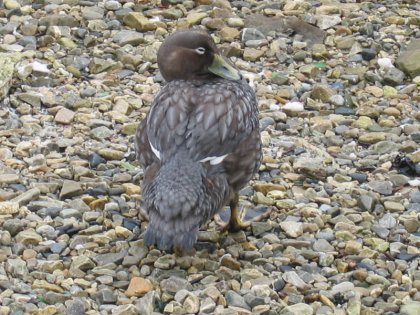|
Our
Beautiful World
|
Shovelers, Tachyeres

Flightless Steamer-duck Tachyeres pteneres
Photo: © http://www.arthurgrosset.com
|
Probaly
Subfamily: Merginae
The most common of them in Tierra del Fuego, Flying Steamerduck , Tachyeres patachonicus, is probably a near relative to the non-flying Flightless Steamerduck, Tachyeres pteneres, i Tierra del Fuego, Falkland Steamerduck, Tachyeres brachypterus, på Falklandsøyene. Flying Steamerduck, Tachyeres patachonicus, No:Patagoniaskovleand   Flying Steamerduck, Tachyeres patachonicus. in Chile it is called 'Quetru volador'' Photo: © http://www.arthurgrosset.com The Flying Steamer Duck, Tachyeres patachonicus, is a steamer duck. It is the most widespread steamer duck, resident in southern Chile and Argentina, Tierra del Fuego and the Falkland Islands. Its plumage is very similar to the other three steamer ducks. It is the only steamer duck which can fly, and the only one to occur on inland fresh waters.  Photo: © http://www.arthurgrosset.com Flying Steamer-duck is smaller with longer, functional wings. The male has a pale to whitish head and orange bill and legs. The female has a dark grey head and a darker bill which is greenish with a yellowish base. Another distinguishing feature of the Flying Steamer-duck is that it usually shows a long, up-curled tail when swimming. Tekst: : © http://www.arthurgrosset.com Most previous observers agreed that steamingbirds power themselves rapidly over the surface of the water using their feet and wings, producing substantial spray and turbulence. Steaming birds attain estimated speeds of up to 25 kph, and they have been seen steaming without pause for 1 km or more. Steaming is used both for escape and for attack during territorial encounters A number of naturalists likened the wing movements of steaming birds to the rotation of side-wheels of steam-boats. "Mechanics of Steaming in Steamer-ducks" by Livezey & Humphrey in Auk, April 1983. Tachyeres pteneres Chileskovleand Flightless Steamerduck  Note the spurs on the wing on the bird on the photo. The orange bumps on the wing are typical of both steamer-ducks, they are modified spurs used in fights. They are often dull and worn down in flightless, and much more pointed and slimmer in flying. Photo: © www.arthurgrosset.com  Photo: © www.arthurgrosset.com  Patagoniaskovleandk, Ushuaia, Tierra del Fuego. White-headed Steamerduck, Tachyeres leucocephalus, No: Hvithodeskovleand  Unknown photographer
Falkland Steamerduck, Tachyeres brachypterus, No:Falklandsskovleand Weibliche Falkland-Dampfschiffente  Falklandsskovleand, Gypsy Cove, Falkland Islands The Falkland Steamer Duck, Tachyeres brachypterus, is a steamer duck native to the Falkland Islands in the southern Atlantic Ocean. It is one of only two bird species to be endemic to the Falkland Islands (Islas Malvinas in Spanish), the other being Cobb's Wren.  Female Falkland Flightless Steamer Duck, Tachyeres brachypterus at Port Stanley. Photo Pismire http://en.wikipedia.org/wiki/File:Tachyeres_brachypterus.jpg
|
 ANIMALS over 250 |
 BIRDS over 500 |
 FLOWERS over 225 |



